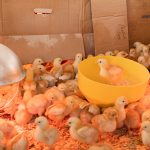Maintaining appropriate temperatures for chickens is essential for their health, welfare, and productivity. Chickens have some natural ability to withstand cold, but they require human intervention to thrive in colder climates. Exposure to extreme cold can lead to serious health issues in chickens, including frostbite, hypothermia, and potential fatality.
The optimal temperature range for chickens is between 50°F and 80°F (10°C to 27°C). When temperatures fall below this range, chickens may experience stress, which can negatively impact their egg production and overall health. Cold conditions also increase chickens’ food consumption as they burn more energy to maintain body heat, potentially raising feed costs for owners.
To ensure the well-being of chickens during colder periods, owners should implement strategies to keep their flock warm. This includes providing appropriate housing with proper insulation and, when necessary, supplemental heat sources. Taking these precautions helps maintain chicken health, sustains egg production, and manages feed efficiency during colder months.
Table of Contents
Key Takeaways
- Keeping chickens warm is important for their health and well-being, especially during cold weather.
- Chickens have a natural instinct to huddle together to keep warm, and this behavior helps them regulate their body temperature.
- Feathers play a crucial role in insulating chickens and keeping them warm, so it’s important to keep their feathers in good condition.
- Huddling and roosting behavior are natural ways for chickens to stay warm, and providing a comfortable roosting area is essential.
- Keeping chickens in a flock provides social interaction and warmth, which can help them stay healthy and happy.
- Providing additional heat sources, such as heat lamps or heated pads, can help supplement warmth for chickens during extreme cold weather.
- Regularly monitoring chicken health and comfort is important to ensure they are staying warm and thriving in their environment.
How Chickens Keep Each Other Warm
Huddling for Warmth
By roosting close together, chickens can share body heat and keep each other warm throughout the night.
Preening for Insulation
In addition to huddling, chickens also engage in preening behavior to help regulate their body temperature. Preening involves the chickens using their beaks to clean and fluff their feathers. This action helps to trap air between the feathers, creating a layer of insulation that keeps the chickens warm.
Staying Comfortable in Cold Weather
By preening, chickens are able to maintain their body temperature and stay comfortable even in colder weather.
The Role of Feathers in Insulation

Feathers play a crucial role in helping chickens stay warm and insulated. The structure of feathers allows them to trap air and create a layer of insulation around the chicken’s body. This layer of air acts as a barrier against the cold, helping to maintain the chicken’s body temperature.
Additionally, feathers are designed to repel water, which is important for keeping chickens dry and warm during wet and cold weather. Chickens have different types of feathers that serve specific purposes in insulation. Down feathers are soft and fluffy and are located close to the chicken’s body.
These feathers provide excellent insulation and help to keep the chicken warm. Contour feathers, on the other hand, are stiffer and provide protection from wind and moisture. By having a combination of different types of feathers, chickens are able to effectively regulate their body temperature and stay warm in various weather conditions.
Huddling and Roosting Behavior
Huddling and roosting behavior are essential for helping chickens stay warm during cold weather. When chickens huddle together, they create a collective body heat that helps them stay warm in low temperatures. This behavior is especially important at night when chickens roost together on a perch.
By roosting close together, chickens can share body heat and keep each other warm throughout the night. In addition to huddling, chickens also engage in preening behavior to help regulate their body temperature. Preening involves the chickens using their beaks to clean and fluff their feathers.
This action helps to trap air between the feathers, creating a layer of insulation that keeps the chickens warm. By preening, chickens are able to maintain their body temperature and stay comfortable even in colder weather.
The Benefits of Keeping Chickens in a Flock
Keeping chickens in a flock provides numerous benefits for their well-being, including warmth and comfort. Chickens are social animals that thrive in the company of others. When kept in a flock, chickens have the opportunity to huddle together for warmth, share body heat, and support each other during cold weather.
Additionally, being part of a flock allows chickens to engage in natural behaviors such as preening and roosting, which help them stay warm and comfortable. Furthermore, keeping chickens in a flock promotes a sense of security and reduces stress for the birds. Chickens feel safer when they are surrounded by their flock mates, which can have a positive impact on their overall health and well-being.
Additionally, being part of a flock encourages natural behaviors such as foraging and social interaction, which contribute to the physical and mental stimulation of the birds.
Providing Additional Heat Sources for Chickens

Heat Lamps: A Common Solution
In cold weather, heat lamps are a popular choice for providing supplemental heat to chickens. They are often used in chicken coops to keep the birds warm during cold nights. However, it’s crucial to position heat lamps safely to prevent fire hazards and ensure that chickens have access to both warm and cooler areas within the coop.
Heated Perches: A Comfortable Option
Heated perches are another effective way to provide warmth for chickens during cold weather. These perches are designed with built-in heating elements that help keep the chickens’ feet warm while roosting at night. This can be a comfortable and cozy option for your flock.
Heated Pads and Temperature Monitoring
Additionally, heated pads can be placed on the floor of the coop to provide a warm surface for chickens to rest on. When using any supplemental heat source, it’s essential to monitor the temperature within the coop and ensure that it remains within the optimal range for chicken comfort. This will help prevent overheating and keep your chickens happy and healthy.
Monitoring Chicken Health and Comfort
Monitoring chicken health and comfort is essential for ensuring that they stay warm and comfortable during cold weather. It is important for chicken owners to regularly check on their flock and observe their behavior and condition. Signs of discomfort or distress, such as shivering or lethargy, may indicate that the chickens are not adequately warm and may require additional heat sources or adjustments to their housing.
In addition to observing their behavior, it is important to regularly inspect the chicken coop for drafts, leaks, or other factors that may compromise its insulation. Proper insulation is crucial for maintaining a warm environment for the chickens. Furthermore, providing adequate bedding such as straw or wood shavings can help keep the coop warm and dry.
Regularly checking on the health of the chickens is also important during cold weather. Cold temperatures can make chickens more susceptible to respiratory illnesses and other health issues. By monitoring their health and providing proper care, chicken owners can ensure that their flock stays healthy and comfortable throughout the winter months.
In conclusion, keeping chickens warm during cold weather is essential for their health and well-being. By understanding their natural behaviors and needs, chicken owners can take proactive measures to ensure that their flock stays warm and comfortable. Providing a cozy environment, promoting natural behaviors, and monitoring their health are all important aspects of keeping chickens warm during cold weather.
With proper care and attention, chickens can thrive even in chilly temperatures and continue to be productive members of the flock.
If you’re interested in learning more about keeping chickens warm, you might want to check out this article on heaters for a chicken coop. It provides helpful tips and recommendations for keeping your chickens cozy during the colder months.
FAQs
What is the natural behavior of chickens to keep warm?
Chickens have a natural instinct to huddle together in a group to keep warm. This behavior helps them conserve body heat and stay comfortable in colder temperatures.
Do chickens huddle together to keep warm?
Yes, chickens often huddle together in a group to keep warm. This behavior is especially common during cold weather or at night when temperatures drop.
How do chickens keep each other warm?
When chickens huddle together, they create a collective body heat that helps keep each other warm. The feathers of the chickens also provide insulation and help retain body heat.
Do chickens need additional heat sources to stay warm?
In most cases, chickens do not need additional heat sources to stay warm as long as they have access to a dry and draft-free coop. However, in extremely cold temperatures, supplemental heat sources such as heat lamps or heated pads may be necessary.
What are the risks of chickens keeping each other warm?
While chickens huddling together can help keep them warm, there are potential risks such as overcrowding, which can lead to aggression and pecking. It’s important to provide enough space for the chickens to huddle comfortably without causing stress or harm to each other.
Meet Walter, the feathered-friend fanatic of Florida! Nestled in the sunshine state, Walter struts through life with his feathered companions, clucking his way to happiness. With a coop that’s fancier than a five-star hotel, he’s the Don Juan of the chicken world. When he’s not teaching his hens to do the cha-cha, you’ll find him in a heated debate with his prized rooster, Sir Clucks-a-Lot. Walter’s poultry passion is no yolk; he’s the sunny-side-up guy you never knew you needed in your flock of friends!







